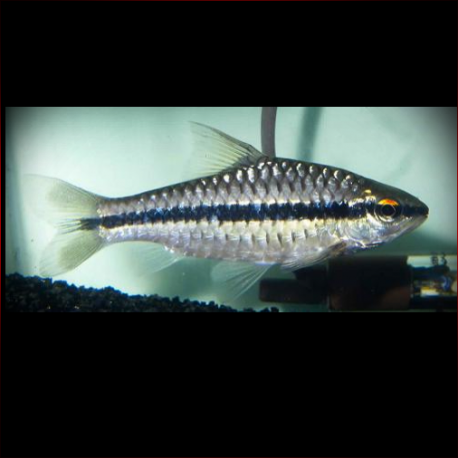More info
Datasheet
| Minimum Tank Size | 270 litres / 71.33 US gallons |
| Maximum Size | 12.0cm / 4.72inches |
| Temperature | 24°C / 75.20°F - 30°C / 86.00°F |
| Hardness | 2.02dgH / 36ppm - 8.01dgH / 143ppm |
| pH | 6.0-7.0 |
General Description: Barbus Holotaenia, commonly known as the Spotscale Barb, is a rare African species in the aquarium hobby. Little information is available about its captive care, but it is believed to be closely related to the cave-dwelling Congo blind barb.
Aquarium Setup: The Spotscale Barb is fairly undemanding and does well in a well-maintained tank with good lighting, a dark substrate, smooth rocks, twisted roots, and live plants. It may appear washed out in sparsely decorated setups, so a more enriched environment is recommended. Water conditions should be maintained at a temperature of 24-30°C, pH levels between 6.0-7.0, and a hardness of 36-143ppm. (see table)
Behaviour: This species is suitable for a peaceful community tank with slightly larger African species like other Barbus, Alestiid tetras, Mochokid catfish, and Ctenopoma. It can also be combined with bold, non-intimidated fish of larger sizes. Spotscale Barbs are schooling fish and should be kept in groups of at least 8-10 for a more natural and less skittish display. Aggressive behaviors are usually contained within the group as they maintain their hierarchical positions.
Feeding and Diet: In the wild, the Spotscale Barb feeds on benthic and terrestrial insects during the wet season and small shrimp and fish scales during the dry season. In captivity, it should be fed a varied diet consisting mostly of frozen and live foods to ensure optimal coloration and health.
Reproduction & Dimorphism: Reproduction behavior in captivity is unreported, but it is recommended to follow the strategies used for other similarly sized cyprinids, such as larger species of Puntius. Male Spotscale Barbs are typically more intensely colored, slimmer, and slightly smaller than females.
Habitat and Distribution: Native to Central West Africa, the Spotscale Barb is primarily found in the Ogooué and Congo River systems. Its range extends across the Democratic Republic of Congo, Angola, Gabon, and Cameroon. This riverine species thrives in well-oxygenated, clean water with a moderate flow, making it suitable for various biotopes within its extensive distribution range.

